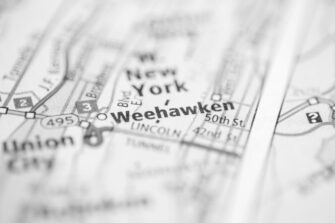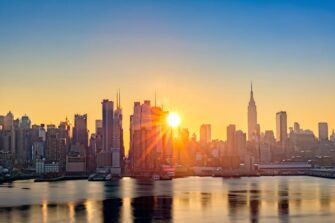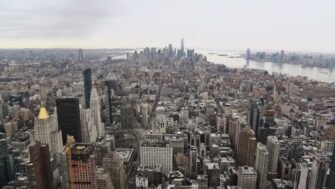Weehawken Street Historic District Personal Injury Attorney

The Weehawken Street Historic District is an enclave of 14 buildings in Lower Manhattan, a time capsule of maritime-related industries. Once part of Newgate State Prison, the area is notable for hosting a produce market and a hotel dating from 1904.
Key Features of the Area
Table of Contents
The Weehawken Street Historic District is centered around Weehawken Street, a street one block long between Christopher and West 10th streets. The street was created on property that had once been part of a colonial prison.
The city opened an open-air produce market there, which proved unsuccessful. But other buildings sprung up in the area that were used as boarding houses, stables, clothing and supply stores, and maritime businesses.
The Weehawken Street Historic District includes all the buildings on Weehawken Street, plus a few properties on Christopher Street and West Street, such as the former hotel at 396-397 West Street dating back to 1904.
The city’s Landmarks Preservation Commission said in 2006 that the picturesque enclave, which includes wood-shingle architecture, illustrates the typical development pattern on the west-side waterfront of Manhattan. Families of prominent long-term owners, such as Cornelius V.S. Roosevelt and former Mayor Stephen Allen, were associated with many of these properties.
Brief History of the Weehawken Street Historic District
 1796: Newgate State Prison, a colonial jail, opens in the village of Greenwich.
1796: Newgate State Prison, a colonial jail, opens in the village of Greenwich.
1829: The state closes the prison due to deplorable living conditions and relocates the remaining prisoners. The city sells much of the prison property but creates Weehawken Street, opening a produce market there called Greenwich Market.
1834: A market house is built for Greenwich Market, also called Weehawken Market.
1844: The produce market closes, and private owners buy the various properties. A brewery opens in one of them.
1848: Shipbuilder George Munson buys one of the market stalls at 6 Weehawken Street and encloses it, adding a second floor and a rear outdoor staircase. An innkeeper and his wife live upstairs and run a saloon for sailors downstairs.
1860s to 1900s: Additional taverns open in the area.
1920 to 1925: Because of Prohibition, the saloon at 6 Weehawken St. is converted into a restaurant, Billie’s Original Clam Broth House.
1943: In one example of the area’s turnover, a retired mariner buys the restaurant at 6 Weehawken St. and sells work clothes, gloves, and tobacco to ship workers and dockworkers.
1946 to 2000s: The former market stall-turned-restaurant and supply store is converted into other businesses, including an X-rated video store.
2006: The city designates all of Weehawken Street and a few surrounding buildings as the Weehawken Street Historic District.
Location
 The Weehawken Street Historic District spans Weehawken Street between West 10th and Christopher Street, as well as a few buildings on those streets. It is near the Hudson River Greenway in the West Village in Manhattan, New York.
The Weehawken Street Historic District spans Weehawken Street between West 10th and Christopher Street, as well as a few buildings on those streets. It is near the Hudson River Greenway in the West Village in Manhattan, New York.
Interesting Facts About the Weehawken Street Historic District
- Weehawken Street itself is rather short: about 266 feet long.
- The Weehawken Street Historic District is roughly one-tenth of a mile from the Hudson River, befitting a former hub of maritime commerce.
- In 2006, French-American millionaire Jean-Louis Goldwater Bourgeois transferred the $4 million deed for the historic residence at 6 Weehawken St. to the Lenape tribe to use as a prayer house in an effort to return the land to Manhattan’s original occupants.
Directions to Belluck Law from the Weehawken Street Historic District
Belluck Law’s NYC office is located in Midtown at 546 Fifth Ave., 5th Floor, New York NY 10036. From the Weehawken Street Historic District, take West 10th Street west to Sixth Avenue, and turn left. Then turn right onto Fifth Avenue.
Our law office also is accessible by taking the F subway train uptown from West Fourth Street/Washington Square Park to 47th-50th Streets/Rockefeller Center.
Call Belluck Law, LLP law firm today!
Our New York City personal injury attorneys have secured almost $1 billion for individuals and families throughout New York City and nearby areas who have been harmed due to dangerous products, serious auto accidents, devastating workplace accidents and unsafe conditions. Call (212) 681-1575 or fill out our online contact form to get started with a free consultation.